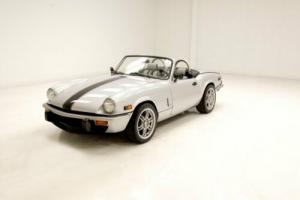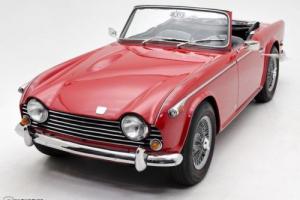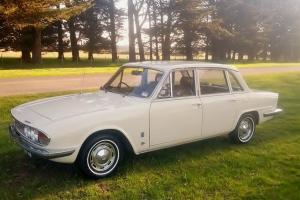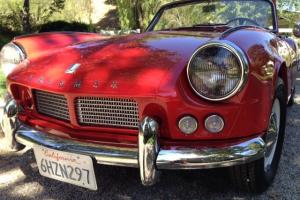Classic Cars / Triumph / Car for sale
Triumph : Spitfire Leather
Sale price: $10,700.00 make an offer
Car location: United States
Sale type: Fixed price listing
Technical specifications, photos and description:
- Year:
- 1963
- Mileage:
- 24,830
- Got questions?
- Ask here!
Triumph : Spitfire Leather for sale
Current customer rating:FULL NUTS & BOLTS RESTORATION COMPLETED in late 2010 by TRIUMPHS ONLY in Stockton. CA.
Paints. mouldings. trim. seats. radio. rebuilt engine. EVERYTHING was done on this classic at a cost of over 26. 00K!!
Less than 200 miles on rebuilt engine.
Comes with custom tonneau cover & car cover.
Turn on the AM radio and you are right back in the 60's.
It rides smooth. no rattles or vibrations.
This is a GREAT weekend cruiser. daily driver for those nostalgic gearheads.
Simply put: It's a real head turner!
WIKI INFO:
The Triumph Spitfire is a small English two-seat sports car. introduced at the London Motor Show in 1962. [3] The vehicle was based on a design produced for Standard-Triumph in 1957 by Italian designer Giovanni Michelotti. The platform for the car was largely based upon the chassis. engine. and running gear of the Triumph Herald saloon. and was manufactured at the Standard-Triumph works at Canley. in Coventry. As was typical for cars of this era. the bodywork was fitted onto a separate structural chassis. but for the Spitfire. which was designed as an open top or convertible sports car from the outset. the ladder chassis was reinforced for additional rigidity by the use of structural components within the bodywork. The Spitfire was provided with a manual hood for weather protection. the design improving to a folding hood for later models. Factory-manufactured hard-tops were also available.
The Triumph Spitfire was originally devised by Standard-Triumph to compete in the small sports car market that had opened up with the introduction of the Austin-Healey Sprite. The Sprite had used the basic drive train of the Austin A30/35 in a light body to make up a budget sports car; Triumph's idea was to use the mechanicals from their small saloon. the Herald. to underpin the new project. Triumph had one advantage. however; where the Austin A30 range was of unitary construction. the Herald featured a separate chassis. It was Triumph's intention to cut that chassis down and clothe it in a sports body. saving the costs of developing a completely new chassis / body unit.
Italian designer Michelotti—who had already penned the Herald—was commissioned for the new project. and came up with a traditional. swooping body. Wind-up windows were provided (in contrast to the Sprite/Midget. which still featured sidescreens. also called curtains. at that time). as well as a single-piece front end which tilted forwards to offer unrivalled access to the engine. At the dawn of the 1960s. however. Standard-Triumph was in deep financial trouble. and unable to put the new car into production; it was not until the company was taken over by the Leyland organization funds became available and the car was launched. Leyland officials. taking stock of their new acquisition. found Michelotti's prototype hiding under a dust sheet in a corner of the factory and rapidly approved it for production.
The production car changed little from the prototype. although the full-width rear bumper was dropped in favour of two part-bumpers curving round each corner. with overriders. Mechanicals were basically stock Herald with the notable addition of front disc brakes. The engine was an 1. 47 cc (1. 1 l) 4-cylinder with a pushrod OHV cylinder head and 2 valves per cylinder. mildly tuned for the Spitfire. fed by twin SU carburettors. Also from the Herald came the rack and pinion steering and coil-and-wishbone front suspension up front. and at the rear a single transverse-leaf swing axle arrangement. This ended up being the most controversial part of the car: it was known to "tuck in" and cause violent over steer if pushed too hard. even in the staid Herald. In the sportier Spitfire (and later the 6-cylinder Triumph GT6 and Triumph Vitesse) it led to severe criticism. The body was bolted to a much-modified Herald chassis. the outer rails and the rear outriggers having been removed; little of the original Herald chassis design was left. and the Spitfire used structural outer sills to stiffen its body tub.
The Spitfire was an inexpensive small sports car and as such had very basic trim. including rubber mats and a large plastic steering wheel. These early cars were referred to both as "Triumph Spitfire Mark I" and "Spitfire 4". 1] not to be confused with the later Spitfire Mark IV.
In UK specification the in-line four produced 63 bhp (47 kW) at 5750 rpm. and 67 lb·ft (91 N·m)of torque at 3500 rpm. This gave a top speed of 92 mph (148 km/h). and would achieve 0 to 60 mph (97 km/h) in 17. 3 seconds. Average fuel consumption was 31mpg. [1]
Also published at eBay.ca
Want to buy this car?
Comments and questions to the seller:
Other classic Triumph cars offered via internet auctions:
 price: $500.001977 Triumph Spitfire
price: $500.001977 Triumph Spitfire price: £5,555.001960 STUNNING TR3A FOR SALE
price: £5,555.001960 STUNNING TR3A FOR SALE price: $64,950.001968 Triumph TR5 PI Roadster
price: $64,950.001968 Triumph TR5 PI Roadster price: $2,995.001972 Triumph 2000 MK2 Sedan 6 Cylinder Automatic Twin Carbs in Wendouree, VIC
price: $2,995.001972 Triumph 2000 MK2 Sedan 6 Cylinder Automatic Twin Carbs in Wendouree, VIC
Latest arrivals:
-
$57,777.000
-
$7,095.950
-
$32,995.000
-
$30,999.000
-
$33,375.000
-
$16,875.000
-
$29,499.000
-
$6,100.000
-
$7,095.950
-
$6,200.000
-
$750.000
-
$29,750.000
-
$8,000.000
-
$22,500.000
-
$500.000
-
$500.000
-
$30,999.000
-
$500.000
-
$500.000
-
$500.000






































